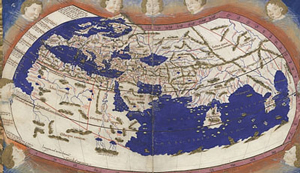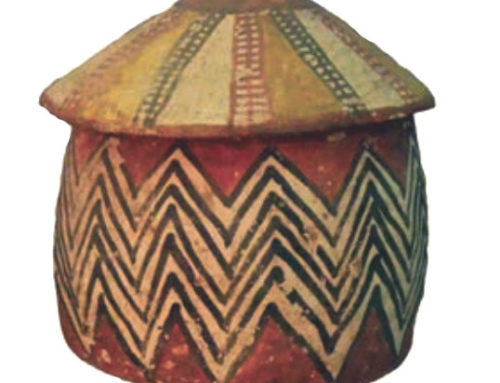
Standing stones at Nabta Playa (modern Sudan), ca. 6000 BC
There are plenty of ideas and inventions that clearly come from sub-Saharan Africa, like astronomical stone circles, domesticated donkeys and cattle, sorghum, feather fans, palm oil, decorated eggs, and raffia clothing. But the large majority of the people in Africa lived along the north and east coasts, where they could trade by boat with other people and build their economy. Trade made the coasts richer, so they could afford more schools, science and scholarship. These people also invented lots of things – as we will see – but their inventions are often called “Greek”, “Roman”, or “Islamic” rather than African. Or their inventions are shunted off into “Egyptian” as if Egypt wasn’t really in Africa.

Donkeys in Old Kingdom Egypt
Ancient Egypt
This is more than just a question of words. When we call an African invention “Egyptian”, often the subtext is “Probably Africans got help inventing this from white people in Mesopotamia, that’s nearby.” All inventors and scholars talk to their neighbors and get ideas from them, but Egyptian scholars spent more time talking to scholars in Sudan and Ethiopia than they did to scholars in Mesopotamia.

Nilometer on Elephantine Island (Nile Valley Tours)
Here I’m thinking of the invention of linen cloth, writing, papyrus, bee-keeping, glass, beer, yeast bread, sundials, Nilometers, artificial incubators for chicken eggs, the shaduf, gum arabic, the use of electric shocks in medicine, and many other medical treatments. Africa is also the source of the first freestanding stone sculpture and stone-roofed buildings, the idea of brailing sails, and probably the first people who sailed all the way around Africa.

Egyptian bee-keeping, 5th Dynasty (Temple of Pharaoh Niuserre at Abu Gorab, ca. 2400 BC)
Carthage and Africa
Similarly, the Phoenician colonization of Carthage doesn’t mean that all the achievements of Carthaginians should just be awarded to West Asia. Carthage probably brought us the first ships sailing up the Atlantic coast of Europe, for example.
Greek Africa
When we call an African invention “Greek”, we often neglect to mention that it happened in Africa, and mislead students into thinking that all these “Greek” inventions happened in Europe. This builds up Europe to seem more central and important than it really was, as if it’s just normal that Europe is always ahead in inventing things, instead of just being richer because of colonialism and slavery. And if a person was born in Greece but moved to Alexandria to work, that’s African work, too. It’s not your skin color or race that makes you discover things; it’s your education, funding, and colleagues.
This would include Aristarchus, who suggested that the earth went around the sun, and Eratosthenes, who was born in Libya and calculated the circumference of the earth in Alexandria, and how far away the moon was. It includes Euclid who wrote a geometry textbook people used for two thousand years, and Archimedes who studied in Alexandria and invented pulleys, among other things.

An Egyptian papyrus from about 100 AD which is a piece of one of Euclid’s books
There’s the doctors Praxagoras, Herophilus and Erasistratos, who worked on human anatomy in Alexandria, and figured out that both veins and arteries carry blood, the difference between blood vessels and nerves, and what the optic nerve is. Egyptians figured out how to trade using Indian Ocean currents, giving a huge boost to the Eurasian economy and setting the stage for European ocean-going trade.

Copy of Eratosthenes’ map of the world
Roman Africa
The same thing happens when we call African scholars “Roman”: most of the people in the Roman Empire didn’t live in Europe, but we often mislead students into thinking that Roman inventions are all European inventions too. Same effect. The Roman playwright Terence came from Africa, though he worked in Rome. The geographer Ptolemy and the philosopher Philo both worked in Roman Alexandria. Christian theologians like Tertullian and Augustine were African, not European; so were Donatus and Arius. Hypatia is famous, but Cleopatra Selene and her husband Juba also wrote science books in Roman Africa.

A copy of Ptolemy’s map of the world
Medieval Africa
And then in the Middle Ages, first there are still way too many people who insist that “medieval” can only apply to Europe, as if there wasn’t a very similar middle time in Africa between the fall of Rome and the rise of the Ottoman Empire. And second, medieval African inventions and scholarship are too easily concealed under the rubric of “Islamic”, with students misled into thinking that all intellectual activity that didn’t come from Europe must have come from Syria or Iraq. By the later Middle Ages, the majority of people in Africa were probably Muslims, and their inventions and ideas are still African inventions and ideas.

Illustration in Ibn al Nafis
This would include al Idrisi‘s map of the world, al-Banna’s work on how to write fractions, Ibn al-Nafis, who figured out that your heart sends blood to your lungs to get air, Ibn al-Haytham, who figured out how eyes work, and Maimonides, whose sensible work on depression and healthy exercise is famous. Ibn Battuta wrote about his travels all over the world, and ibn Khaldun wrote economic theory. Knitting, used to make most of your clothes, was probably invented in early medieval Egypt. Oh, yeah, and coffee comes from Africa.

Diagram of an eye, by Ibn al-Haytham (ca. 1000 AD)
Okay, rant over. But if you are teaching black science for Black History Month, now you can be specific. You’re welcome.




